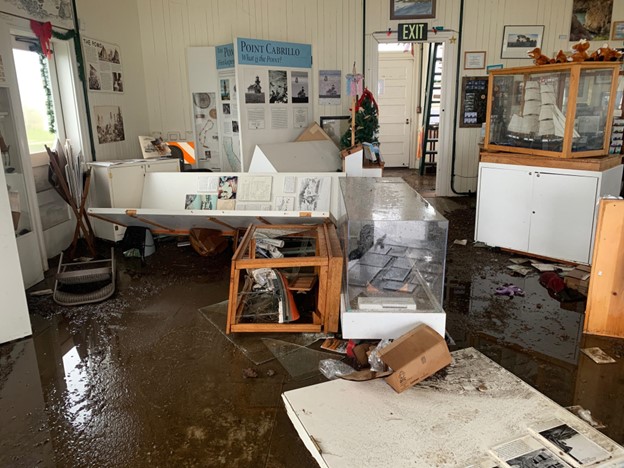
The inside of the lighthouse was a mess after the big wave washed through it.
A few days into this new year, a little after 8:00 am on January 5th, a large wave scaled the 50-foot bluff in front of the Point Cabrillo Lighthouse, broke down the double front doors, and flowed through the main room all the way to the back door. It deposited mud and gravel everywhere, damaged the interpretive exhibits and destroyed some of the stock in the gift shop maintained by the Point Cabrillo Lightkeepers Association. The previous day the National Weather Service had warned that, in addition to storm-force winds and intense rainfall, large swells of up to 30 feet could pummel the coastal bluffs during high tides. The big wave arrived at the lighthouse about an hour before the highest tide, but it brought mayhem nonetheless.
In the messy aftermath, and amid much media coverage and many post office conversations about bomb cyclones, atmospheric rivers, climate change, and “unprecedented,” and “record-setting” events, I wondered whether anything like this had happened before. Thanks to Bruce Rogerson, Point Cabrillo’s historian and co-author of the perennial favorite, Point Cabrillo (Mendocino Historical Review XXIII), I learned that it had.
In the 114 years since the beacon was first lit in June, 1909, the lighthouse has been damaged by monster waves at least twice, first on Christmas Eve, 1928. In a severe wind storm that night, the windows on the west side of the building were broken by heavy seas; water flowed through the “fog signal room” and out the east-facing door. At that time, the fog signal room held only the compressors that powered the fog horns on the roof, and it was possible to keep the elevated engines going while water and sand were swept out.
In the Lightkeeper’s Log, viewable now in the East House museum at the light station, a handwritten entry by the Head Lightkeeper reads as follows: “Point Cabrillo Light Station, Christmas eve of 1928, early in the evening there was a light NW wind blowing and a very heavy sea running outside. About 9 pm, heavy winds came in from the southwest. Seas started to roll over these banks about 60 feet high, by midnight. The steamer Noyo – and the steamer Caspar from the Caspar Lumber Co. – would go down in deep swells and we could just pick out the running lights on the masts. The steamer Caspar was having engine trouble and started to drift toward the station. We had rocks on the grounds from the storm which weighed as much as 200 pounds. Fence posts 8 x 8 with barbed wire were broke off and washed back about 400 feet from the ocean. I moved everyone up to the east house to be safe!”
Thirty-two years later, on February 8th and 9th, 1960, monster waves engulfed the lighthouse, ripped off siding, and upended the fog horn compressors inside. Outside, boulders and gravel were scattered around the building and for many yards inland. Bill Owens, head keeper at Point Cabrillo at the time, was quoted in a 1970 newspaper article as follows: “Maybe the most memorable event [of his tenure] was the storm of 1960. The waves were coming up over the bluffs and running right around the fog signal building.” The massive waves were caused by a series of very strong low-pressure systems in the northern Pacific entraining large swells aimed at the northern coast of California and southern Oregon. Strong cyclonic winds associated with a low pressure weather system in the Gulf of Alaska created ocean waves of up to 40 or 50 feet. During the time such waves move from the storm source to the West Coast, wave harmonics can lead to a situation in which wave crests catch up with preceding wave crests and create even larger “rogue waves” or “sneaker waves.”
Sound familiar? This week, a number of climate researchers were quoted in the Los Angeles Times saying the recent storms appear to be typical of the intense, periodic rains that have struck California nearly every decade since records were first kept in the 1850s, and not the result of global warming. Whatever the case may prove to be, the Point Cabrillo Lightkeepers staff, volunteers, and board members have spent most of January cleaning up the mess, and they are making plans to reopen the lighthouse on Saturday, January 28th. Show your support for one of our coastal treasures by walking down to the lighthouse and buying something. If you would like to donate to the Point Cabrillo recovery fund, please visit their website: https://pointcabrillo.org
The Kelley House Museum is open from 11AM to 3PM Thursday through Sunday. If you have a question for the curator, contact her at curator@kelleyhousemuseum.org to make an appointment. Walking tours of the historic district depart from the Kelley House regularly.